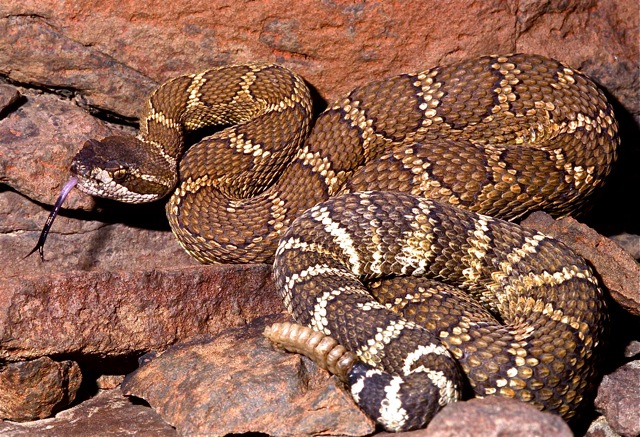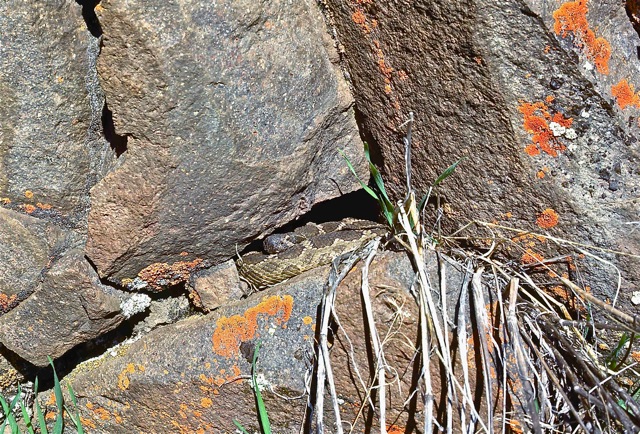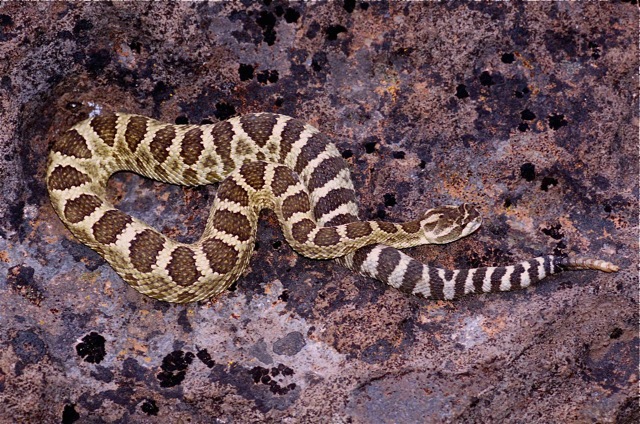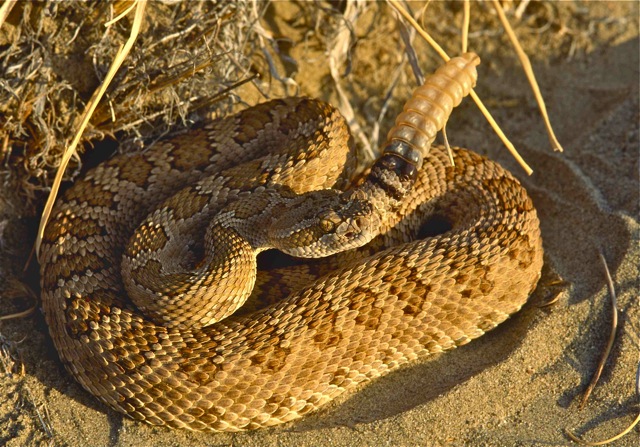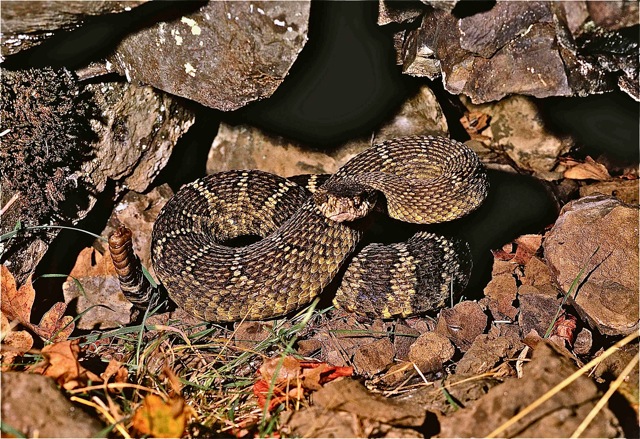The rattlesnake is the only dangerously venomous reptile in Oregon. Among the state's native wildlife, few other animals generate as many fears, false perceptions, and tall tales. In reality, however, few people see rattlesnakes in the wild. They want to be left alone and will never advance toward a human. Even when cornered, a defensively coiled rattlesnake can strike outward with just the forward half of its body. Anyone six feet or more away is well outside biting range.
Although it is commonly believed that diamondbacks and timber rattlesnakes live in the Pacific Northwest, the only indigenous species in the region is the western rattlesnake (Crotalus oreganus). These wide-ranging reptiles are found in dry, rocky regions west of the Continental Divide, from Mexico to Canada. They are relatively small, averaging about thirty inches in length, with occasional individuals reaching forty-eight inches. Rarely, sixty-inch specimens have been documented.
Western rattlesnakes blend well with the environment. In forested areas, they are dark with large blotches; in open deserts and prairies, their coloring is lighter with smaller blotches. Several geographic variations are classified as different subspecies, with two occurring in Oregon.
The brown to greenish-brown Northern Pacific rattlesnake (Crotalus oreganus oreganus) has large, squarish blotches. In western Oregon, they occupy oak habitats in the Klamath/Siskiyou Mountains and the Rogue River, Umpqua, and Willamette Valleys. In central and northeastern Oregon, they live in sun-drenched pine and juniper woodlands.
The other subspecies is the Great Basin rattlesnake (Crotalus oreganus lutosus), which is native to the deserts and sagebrush steppelands in southeastern Oregon. Their buff-tan coloring and small, oval blotches match the arid surroundings there.
The ranges of these two subspecific variations meet along an arc that stretches northeastward from Klamath Falls, through Burns, to the Snake River near Baker City. Within that zone, all rattlesnakes have a blending of characteristics of both subspecies.
Generally, rattlesnakes do not live in Oregon's mountains above 6,000 feet, and the climate is too cloudy and wet for them along the coast. At northerly latitudes, rattlesnakes hibernate communally through the winter on south-facing slopes. In autumn, as conditions become colder, they congregate at rocky dens and retreat into deep crevices. When springtime warmth arrives, they emerge and disperse into the surrounding area for the summer.
It is a common misconception that a rattlesnake's age can be determined by counting its loosely interlocking rattle segments. Actually, a new segment is added at the base of the rattle each time it sheds its skin, and a rattlesnake sometimes casts its epidermis more than once a year. As the rattle becomes longer and more fragile, some of the segments break off.
A rattlesnake's fangs are connected to glands on each side of the animal's broad head, efficiently injecting venom for both defense and the killing of food. Rattlesnakes are pit vipers, with a small heat-sensing indention on each side of their snout that detects warm-blooded prey for better striking accuracy in the dark. If a person is bitten by a rattlesnake, the current recommendation is to quickly find medical care for antivenom treatment rather than administering first aid.
Even though rattlesnakes eat rodents and are a benefit to farmers, they are not winning popularity contests. In densely populated western Oregon, rattlesnake populations are declining because of extermination efforts—for example, dynamiting their dens—and habitat loss. Historically, rattlesnakes in the Willamette Valley inhabited areas with rocky hillsides, from Cottage Grove northward nearly to Portland. During the 1850s, the Bush Park neighborhood in Salem was known as Rattlesnake Hill. Now, rattlesnakes survive in a few southern sections of the valley, being extirpated from their former territories in Benton, Polk, Yamhill, and Clackamas Counties.
-
![Northern Pacific Rattlesnake (Crotalus oreganus oreganus); Deschutes River Canyon near Madras, Central Oregon.]()
Northern Pacific Rattlesnake (Crotalus oreganus oreganus).
Northern Pacific Rattlesnake (Crotalus oreganus oreganus); Deschutes River Canyon near Madras, Central Oregon. Courtesy Alan St. John
-
![Northern Pacific Rattlesnake (Crotalus oreganus oreganus) found in the Sheep Rock Unit of John Day Fossil Beds National Monument in eastern Oregon.]()
Northern Pacific Rattlesnake (Crotalus oreganus oreganus) .
Northern Pacific Rattlesnake (Crotalus oreganus oreganus) found in the Sheep Rock Unit of John Day Fossil Beds National Monument in eastern Oregon. Courtesy Alan St. John
-
![Northern Pacific Rattlesnake (Crotalus oreganus oreganus) emerging from its den on a warm April day. Near Sisters, Central Oregon.]()
Northern Pacific Rattlesnake (Crotalus oreganus oreganus) .
Northern Pacific Rattlesnake (Crotalus oreganus oreganus) emerging from its den on a warm April day. Near Sisters, Central Oregon. Courtesy Alan St. John
-
![Typical intergrade between the Northern Pacific and Great Basin subspecies, showing mixed characteristics for both of these geographic variations of the Western Rattlesnake. Found in the Bear Creek drainage, near Brothers in Central Oregon.]()
Typical intergrade between the Northern Pacific and Great Basin subspecies.
Typical intergrade between the Northern Pacific and Great Basin subspecies, showing mixed characteristics for both of these geographic variations of the Western Rattlesnake. Found in the Bear Creek drainage, near Brothers in Central Oregon. Courtesy Alan St. John
-
![Northern Pacific Rattlesnake (Crotalus oreganus oreganus) basking in evening light at a den in the southern Willamette Valley.]()
Northern Pacific Rattlesnake (Crotalus oreganus oreganus) .
Northern Pacific Rattlesnake (Crotalus oreganus oreganus) basking in evening light at a den in the southern Willamette Valley. Courtesy Alan St. John
-
![Close view of the infamous rattle. The segments are loosely interlinked like a chain, producing a startling "buzz" when the snake vibrates its tail at high speed.]()
Close view of the infamous rattle..
Close view of the infamous rattle. The segments are loosely interlinked like a chain, producing a startling "buzz" when the snake vibrates its tail at high speed. Courtesy Alan St. John
-
![Great Basin Rattlesnake (Crotalus oreganus lutosus) in Big Sand Gap, Alvord Desert, SE Oregon.]()
Great Basin Rattlesnake (Crotalus oreganus lutosus).
Great Basin Rattlesnake (Crotalus oreganus lutosus) in Big Sand Gap, Alvord Desert, SE Oregon. Courtesy Alan St. John
-
![Northern Pacific Rattlesnake (Crotalus oreganus oreganus) at its den. East of Salem in Marion County, Willamette Valley, Oregon.]()
Northern Pacific Rattlesnake (Crotalus oreganus oreganus).
Northern Pacific Rattlesnake (Crotalus oreganus oreganus) at its den. East of Salem in Marion County, Willamette Valley, Oregon. Courtesy Alan St. John
Map This on the Oregon History WayFinder
The Oregon History Wayfinder is an interactive map that identifies significant places, people, and events in Oregon history.
Further Reading
Klauber, Laurence M. Rattlesnakes: Their Habits, Life Histories, and Influence on Mankind. 2d ed. 2 vols. Berkeley: University of California Press, 1997.
St. John, Alan. Reptiles of the Northwest: California to Alaska, Rockies to the Coast. Edmonton, Alberta: Lone Pine Publishing, 2002.
Stebbins, Robert C. A Field Guide to Western Reptiles and Amphibians. New York: Houghton Mifflin, 2003.

